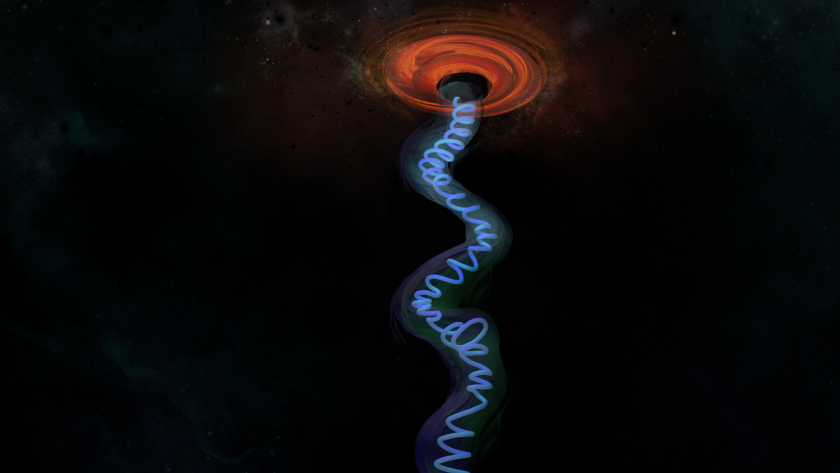Recently, all-inclusive high-time resolution optical monitoring of BL Lacertae (BL Lac)—a distant active galaxy—was conducted by a group of 86 scientists from 13 countries. One of the astronomers contributing to this project is Mike Joner, BYU Research Professor of Physics and Astronomy.

Artistic rendering of the BL Lac jet with a spiral magnetic field. Image Credit: Iris Nieh.
At the BYU West Mountain Observatory, Dr. Joner and BYU undergraduate student Gilvan Apolonio secured more than 200 observations of the galaxy with the use of the 0.9-m reflecting telescope. Their measurements were united with observations done by other researchers across the globe in an association called the Whole Earth Blazar Telescope (WEBT). In a high variability period, the WEBT network enables the monitoring of objects continuously from various locations.
Astronomers found shockingly fast oscillations of brightness in the galaxy BL Lac’s central jet, with the WEBT observations noticed in the summer of 2020. The researchers accredit these brightness change cycles to twists in the magnetic field of the jet. Nature, a scientific journal, recently published this study.
The West Mountain Observatory of BYU was one among the 37 ground-based telescopes across the globe monitoring the optical variations of BL Lac—an active galaxy categorized as a blazar that is approximately 1 billion light years away.
Joner and Apolonio substituted each other working on various groups of nights at the observatory all through the summer and spring of 2020—a task that was extra arduous at the peak of the pandemic. This unusual task schedule was essential as observations were required on all clear nights and no other skilled student observers were remaining in the Provo region.
An investigation of the high-cadence optical observations was vital to comprehending the high-energy observations from the space-based Fermi Gamma-Ray Telescope.
You need to combine data from high-energy space observatories with optical ground-based monitoring data. The billion-dollar space telescopes that are used on projects like this often need to compare results with optical ground-based observations. Correlating what was seen in the high energy observations with the ground-based light curves helped confirm the rapid periodic oscillations that were observed in the high-energy data from space.
Mike Joner, Research Professor, Physics and Astronomy, Brigham Young University
Despite being a recognized specialist in astrophysical research, Joner states that he is still surprised at the level of detail researchers are capturing via such observations. He is also thankful for the opportunity to explore the wide range of the cosmos along with his students at BYU.
On a galactic scale, the central jet of a blazar is quite small. It is amazing to be able to see the variations of the jet so clearly. The variability of the jet is easily seen even though it is combined with the light from the hundreds of billions of stars in the host galaxy. It is noteworthy that in this age of giant telescopes and space-based research, it is still necessary to rely on modest sized and well-equipped facilities like we have available at BYU to explore the unknown reaches of the Universe.
Mike Joner, Research Professor, Physics and Astronomy, Brigham Young University
Boston University Doctoral Student Melissa Hallum, a BYU graduate and former student of Dr. Joner’s, was also a co-author of the study.
Journal Reference
Jorstad, S. G., et al. (2022) Rapid quasi-periodic oscillations in the relativistic jet of BL Lacertae. Nature. doi.org/10.1038/s41586-022-05038-9.